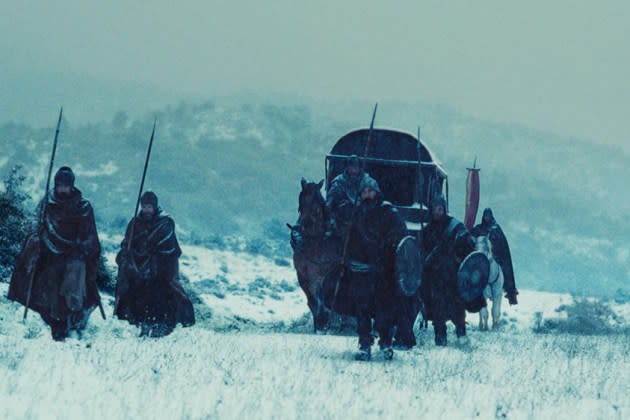Power, Religion and the Place of Women Dominate Antonio Chavarrías’ High-Profile Malaga Competition Contender ‘Holy Mother’

A Malaga competition contender, Antonio Chavarrías returns to the festival with “Holy Mother,” (“La abadesa”). His latest venture, sold by Film Constellation, transports us to the 9th century where Emma, a newly appointed abbess, is tasked with the formidable challenge of repopulating and revitalizing frontier lands on the edge of Muslim territorie,s at the bequest of her powerful family.
The film was set up at Chavarrias’ Barcelona-based Oberon Cinematográfica with Wanda Visión, Icono 2020 AIE, and Saga Film.
More from Variety
At the story’s center is Daniela Brown’s (“Días Mejores,”) portrayal of Emma, a young abbess whose divine conviction is matched only by her unyielding resolve. “Emma always thinks that her power emanates directly from God; in that conviction there is a certain naivety,” reflects Chavarrías.
The portrayal illuminates Emma’s journey, as she navigates a maze of societal expectations and political intrigue, her every action surrounded by doubters.
“Ignorance preserves innocence,” one monk tells her. Few of the fellow sisters are there for devotion, but rather have been sent by their families for a variety of reasons. One is Eloisa played by Blanca Romero who is a woman unafraid of life’s passions antagonizing the chaste Emma as being more object than true woman.
The sparse interiors are shot intimately as if an unseen character is watching. The cloistered environs open out to exterior scenes of the majestic but harsh winter landscape around Huesca and Lleida in the Pyrenean north of Spain. “This film was born from a very long and demanding preparation, in which all the teams and actors were involved.” Chavarrías says. “However, at the time of filming, we allowed everything that was uncontrollable to shape it: the light, the weather, the improvisations, the discoveries that appeared on the fly. At the beginning of the day we almost never knew for sure how we would end it. I think that this decision to bet on intuition generated more vivid and intense images on many occasions — in some way they have provided a truth that was impossible to plan.”
Chavarrías varied career spans a wide range of films, from the Spanish giallo “Una ombra en el jardín” (1989), through the immigrant-junkie drama “Susanna” (1996), the familial conflict in “Volverás” (2002), the procedural “Las vidas de Celia” (2005), to the Trotsky assassination thriller “The Chosen” (2016).
“I’m not really looking for a certain type of story; I find it, or maybe they find me. But there is no love at first sight. The ideas take shape as the characters grow in my head, until there comes a moment when an obsessive desire to tell that story is born.” Chavarrías tells Variety.
Variety caught up with the filmmaker prior to its competition bow:
Historical accuracy versus artistic license can be a delicate balance in films based on true stories. Can you discuss any specific instances where you chose one over the other for the sake of the film’s story or impact?
In this case I have not had to face the dilemma of confronting fiction with respect for real history. Hardly anything is known about Emma about her personal life or details of the conflicts that led to her trial; everything is conjecture that has allowed me to construct the fiction with complete freedom.
Within the Abbey the camera has the perspective of another person in the room, often handheld, watchful and intimate. What drew you to this approach?
The script is presented as a fable; in its first versions it was divided by labels that indicated the different stages of the story. I already had that idea of the external narrator from the beginning, which is why subjective shots practically do not exist. This distance also contributes to not taking sides with any character, letting them express their points of view.
The film highlights the unity of Emma, Eloisa and Clara through their shared condition as women in a rights-denying world, and this despite them being very different people. Given the film’s intricate exploration of faith, gender and power, what kind of conversation do you hope it sparks among audiences?
You could say that the film talks about how these three women fight against a destiny that has been imposed on them. They put all their strength into escaping from it while having everything against them. And they do it from very different positions and beliefs. From the beginning I was very careful not to judge them, to respect them as they were, to let them be the ones to mark the path of history. I think that this attitude allows the public to draw very different consequences from the story, and that seems very good to me. The proposal is open to the viewer’s gaze to close its interpretation.
There is a harshness to the location, we see poverty, starvation and the battle for the community to survive against the elements. How important was the locations and capturing its climate well to convey the reality of living in this time?
Our decision was not to shy away from that harshness that occurred naturally in the locations where we filmed. We deliberately filmed in the months of January and February, the most extreme months of the year. The snow almost buried us some days; the icy wind inside the convent made us shiver all the time. Everything helped to forge the film’s dramatic and aesthetic registers. Everything formed a single body with the story we were telling.
Best of Variety
Sign up for Variety’s Newsletter. For the latest news, follow us on Facebook, Twitter, and Instagram.
